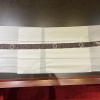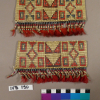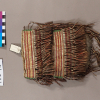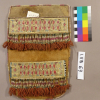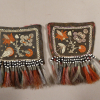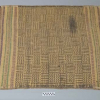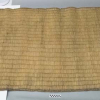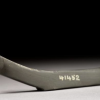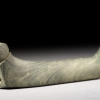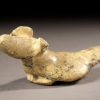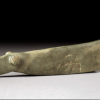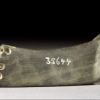Relatives/Heritage items
Displaying 1 - 20 of 4690 Relatives
Browsing allows you to see all the records for relatives and heritage items in the GKS. You can also search by material made, and/or filter by nations. To search by material made, type the material's name, by example 'leather', in the box below and click “Apply.” You can select multiple nations from the dropdown list by pressing “Ctrl” (on PC) or “Command” (on Mac) and clicking, then select “Apply.”
This relative, a wampum belt, is long and narrow. There are three white circles on a purple field. The belt has 8 horizontal rows of beads. One end of the belt has a fringe created from the warp. The other end of the belt appears
This pair of quillwork bands were made to be attached to a bag. Although the Museum record identifies these as Sioux, GRASAC researchers believe these are Cree from James Bay because of the red, blue and natural colours of the quills. There are geometric designs
This hide pouch with two loom woven quillwork panels may be quite old, dating to the 18th century, and possibly the first half of the 18th century (1700-1750). It is a two-piece construction, and the seam is visible. The quilled panels are sewn onto hide
This rectangular, hide pouch has two pockets that each extend to the bottom of the bag. It has been decorated with two bands of loomed quillwork with designs created in yellow, white, red (now appears as pink), purple and blue (now blue/green). Each band was
This single moccasin, mkizin, is missing its mate. It is constructed from a single piece with a centre seam decorated with woven quillwork. The flaps, each with their own woven quillwork band, were added on. The quills are red, white, black and blue/turquoise. There are
This relative is a hide pouch, with a black smoked front panel, unblackened back panel, and an unblackened strap featuring quill embroidery. It also has an unusually large number of tinkle cones compared to other bags. The strap has been sewn to the pouch and
This set or pair of black smoked hide patches is adorned with fine quill, moosehair embroidery, or both. The bottoms of these relatives are edged with black and white beads ending in tiny tinkle cones and dyed moose or deer hair. The hair has been
This pair of garters or arm bands are quilled in red and white, with beaded tassels on the ends. They are a combination of porcupine and bird quills, with GRASAC researchers believing that the quills running lengthwise are split bird quills, woven through what are
This two-tabbed pouch has very distinct and complex quillwork. The quillworker produced intricate positive and negative spaces. One of the taps at the top of the pouch has two lines of quill decoration in white and orange (originally red) - though some of the quills
This two-tabbed, or two-eared, pouch is crafted from smoked and brain-tanned hide. It's name reflects the two ears or tabs at the top. There is quill decoration in dark purple (originally black), white, and orange (originally red) just under the taps. There is a larger
This ancestor is a fringed and beaded collar made from hide, glass, newspaper, and cotton thread. The collar is semi-circular in shape, and presents a beaded floral motif through the use of spot stitching techniques. The floral motif has a central white floral design with
This naakan bullrush mat, crafted around the 1880s, has a tan body with vertical ladder motifs and a central checkerboard grid featuring alternating horizontal rows in vibrant shades of yellow, green, indigo, and magenta. Originally one of five bullrush mats acquired by Harrington in 1905
This relative is a naakan rush mat, made of bullrush basswood. Tan in colour, this mat has 23 weft rows and no patterned motifs. This mat is one of five bullrush mats purchased by Harrington in 1905, a field collector working for the Peabody Museum
This ancestor has a ridged back, a broken beak, and a broad, circular and convex base with two perforated protruding feet. It has two projecting globular eyes but the left one is broken. This birdstone is beige with medium grey laminations. Following the break of
This ancestor has a pointed beak, angular fan-shaped tail, and a trapezoidal base that is perforated at both ends. Medium grey in colour with thin black laminations, this birdstone has a flat base and a long body with a raised head and tail. The eyes
This ancestor is a birdstone fragment and is grey/green in colour. With high banding spanning its entire body, this ancestor has a broken head but its neck fracture was smoothed. This birdstone also has an incised line around its neck, which might have been used
This ancestor is a pop-eyed birdstone, named so because of the large stemmed eyes on the top of its head. It is a tan colour with black minerals. This birdstone has a long beak which has a broken tip. Its base is broad, circular and
This ancestor has a curved elongated beak, a long rectangular body, downward head and a raised tail. This birdstone is green and tan, with dark and light laminations, and curved bands of yellow discolorations or stains along the bottom where the birdstone rests. This ancestor
This ancestor is a fragment of a birdstone, with a raised tail. It is made of smooth meta-rhythmite and is dark green-grey in colour with light grey laminations. It is a fragment of the bottom half of the birdstone. This fragment is perforated through its
This ancestor is a fragment of a pop-eyed birdstone with notches on the top of its head, on its beak, back and around its right eye. It is made of a stone with a dark grey-brown colour, and with black lineations. This ancestor is distinct
 Knowledge Sharing Platform
Knowledge Sharing Platform

